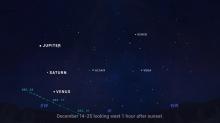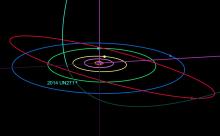Listen to today's episode of StarDate on the web the same day it airs in high-quality streaming audio without any extra ads or announcements. Choose a $8 one-month pass, or listen every day for a year for just $30.
You are here
Comet Wirtanen
It’s prime time for the celestial bull. Taurus is well up in the east at nightfall, and climbs high across the sky later on. Look for his bright orange “eye” — the star Aldebaran — with his shoulder — the Pleiades star cluster — standing above it. And over the next few nights, a visitor will streak across the constellation.
Comet Wirtanen just made its closest approach to the Sun for its current orbit, a bit outside Earth’s orbit. As the comet heads away from the Sun, it’ll fly past Earth. It’ll make its closest approach on Sunday night, at a distance of about seven million miles. That’s the 20th-closest approach by a comet ever recorded.
Astronomers are taking advantage of that approach. They’re measuring the size and rotation of the comet’s nucleus, which is less than a mile across. And they’re measuring the composition of the comet and its long tail.
Because we record our show in advance, we can’t tell you how bright the comet will become. But some predictions say that, under dark skies, it could be bright enough to see with the unaided eye. From brighter areas, you’ll probably need binoculars or a telescope.
Tonight, Wirtanen will stand far to the right of Aldebaran and the Pleiades. But it will pass between them on Sunday night — closer to the Pleiades than Aldebaran. After that, it’ll sweep off to their left, quickly leaving the bull behind — but perhaps staying bright enough to watch for a few more weeks.
Script by Damond Benningfield





